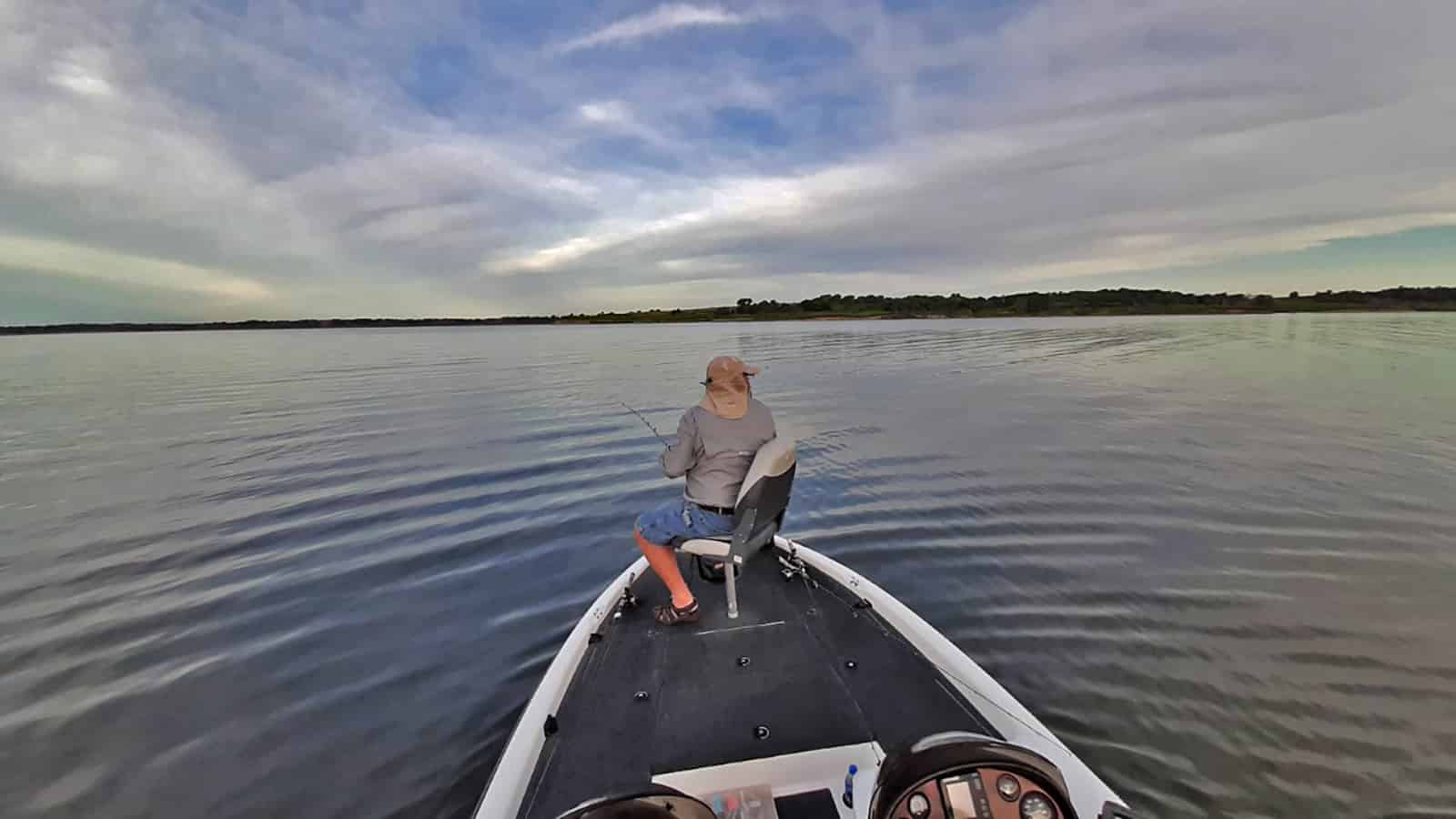Kansas is a Midwest state with abundant natural areas. The state may not have any coastal regions, but it does have numerous lakes and rivers. People travel to these bodies of water to go fishing, swimming, and boating. Some of the lakes have more diverse wildlife than others, including reptiles. Take a look at the most snake-infested lakes in Kansas to learn about the places where you are most likely to encounter a snake.
This list is not meant to scare readers. It is meant to be informative so people know what areas tend to have more snakes than others while also educating them about the species that they can encounter. That way, they do not have adverse interactions with snakes out of fear or a lack of education.
What Snakes Live in Kansas?
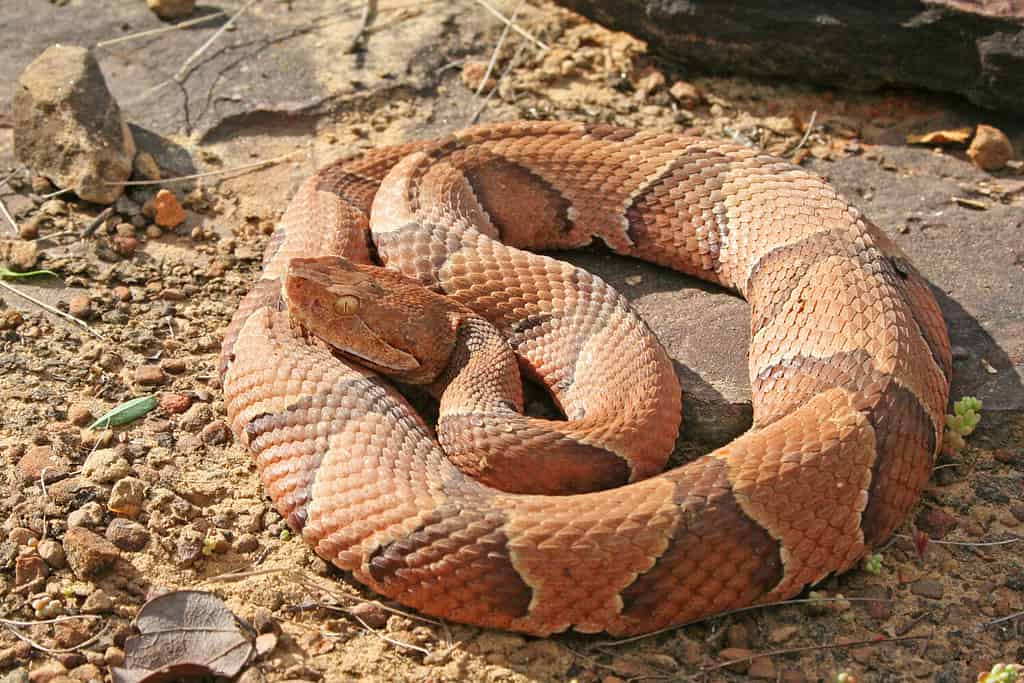
Copperhead snakes are the most common venomous species in Kansas.
©Creeping Things/Shutterstock.com
A wide assortment of snake species live in Kansas. About 42 species of snakes live in Kansas, and the vast majority of them are nonvenomous. Only 5 species of snakes in Kansas are venomous and capable of delivering a medically significant bite. Venomous snakes in Kansas include:
- Cottonmouth
- Copperheads
- Timber rattlesnake
- Prairie rattlesnake
- Western massasauga
The western diamondback rattlesnake also appears in the state from time to time, but they’re not a common resident species. Copperhead snakes are the most common venomous snake found in the state. Meanwhile, cottonmouths are very rare except in the southeastern part of the state. Cottonmouths, also called water moccasins, are semi-aquatic.
Even so, only about two people have died from snake bites in the state, and those deaths occurred in the 19th century.
According to the Centers for Disease Control and Prevention, only 5 people die from snakebites each year despite 7,000 to 8,000 venomous snakebites in the U.S. So, the 5 species of venomous snakes in Kansas, when treated with respect, are not a grave threat to people that act wisely around them.
Common Snakes Found in Kansas Lakes
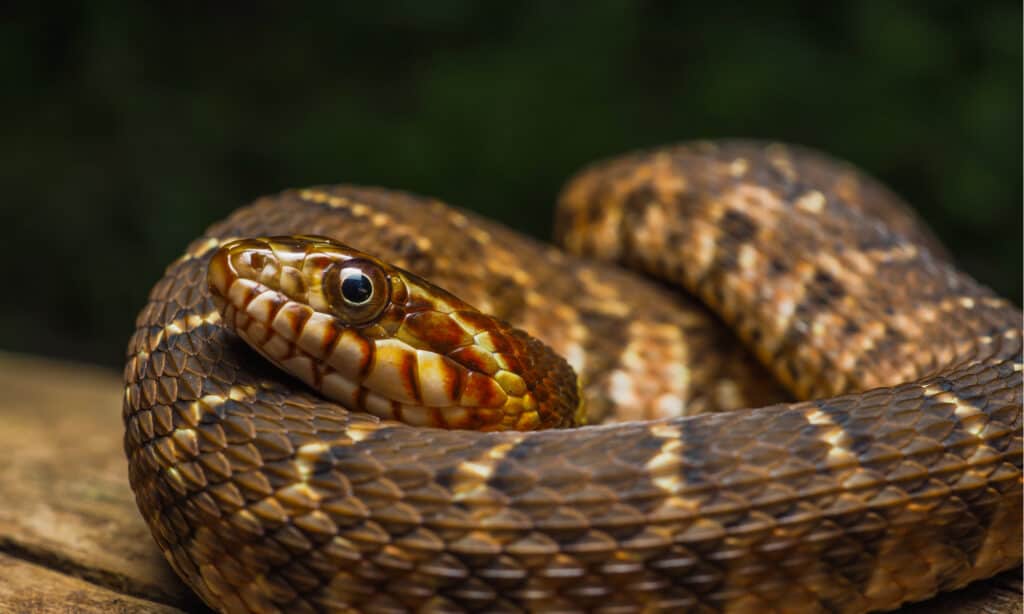
Plain-bellied watersnakes are a semi-aquatic species living in the region.
©Tyler Albertson/Shutterstock.com
Many snake species spend time near wetlands. Some of them are semi-aquatic, meaning that they gain most of their diet from animals that live in the water. They’ll eat fish, insects, amphibians, and other animals that live in or near water.
Some semi-aquatic snakes that people will find in and near water in this area include:
- Common watersnake (northern watersnake)
- Plain-bellied watersnake
- Diamondback watersnake
- Cottonmouths
Of course, other snakes live near the water. The common watersnake is among the most common snakes in the state and the one that most people will run into at a lake. However, it may bear a passing semblance to a cottonmouth snake, causing people to worry.
The chances are that neither of these snakes will bother a person unless they are cornered, harassed, or handled. The best approach to this situation is to simply leave them alone. If you spot one, move away slowly. The reptile will usually seek the fastest path away rather than cause any problems.
The Most Snake-Infested Lakes in Kansas
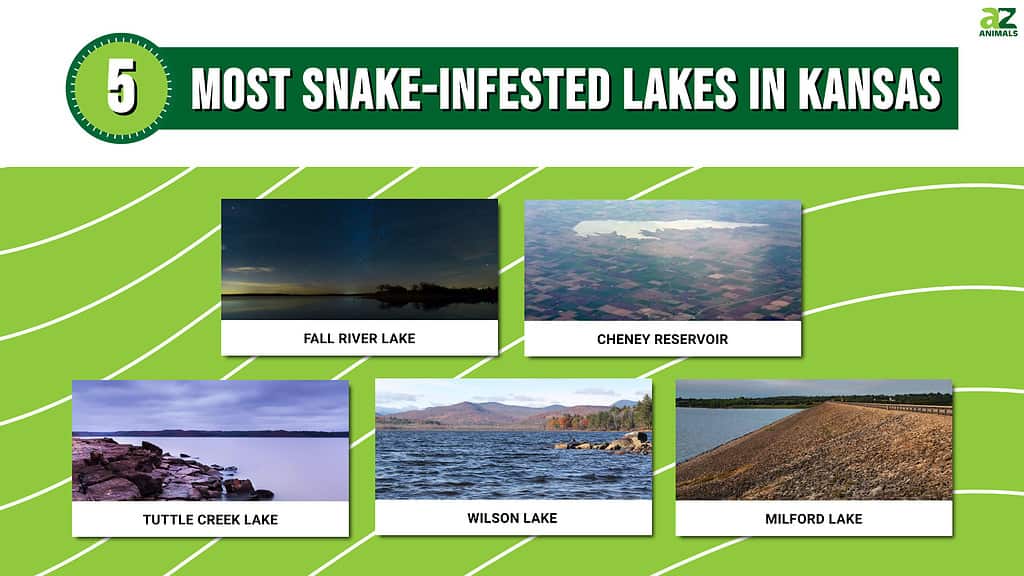
Kansas has several lakes, and a few of them have high populations of snakes. The lakes with the greatest number of snakes are typically those that have a large enough environment to support them. So, the lakes on this list of the most snake-infested lakes in Kansas tend to also be the largest lakes containing the biggest wetlands that support snake life.
5. Fall River Lake

Fall River Lake located in the Fall River State Park is home to several snake species including copperheads.
©Yev Zakharov/Shutterstock.com
Fall River Lake in Kansas is in the Fall River State Park, a 980-acre park that offers campgrounds and opportunities to enjoy water recreation. The park has received a bit of attention in the news in recent years due to its snake population.
In particular, game wardens culled some of the copperhead population in the area following a venomous bite that occurred in the park. Other snakes live near the lake as well, including the common watersnake and the western milk snake.
4. Cheney Reservoir
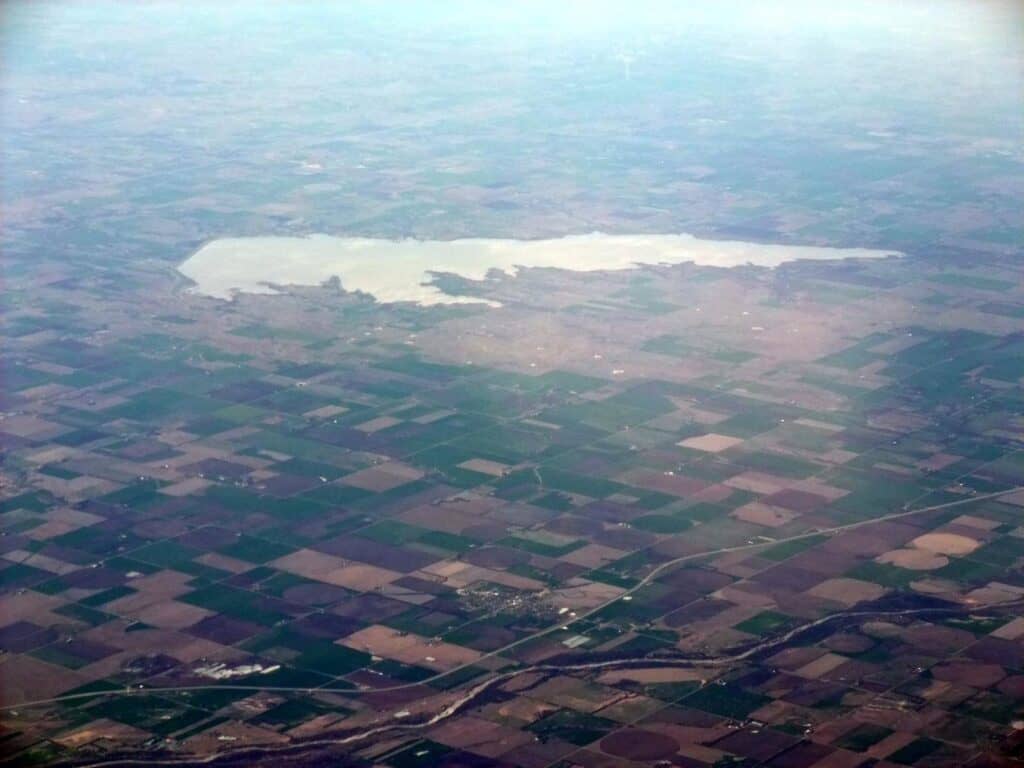
The Cheney Reservoir is one of the premier outdoor recreational areas in the southern Kansas area
Cheney Reservoir is a large man-made lake that is west of Wichita. The reservoir is 9,550 acres with a state park along its shores. This region is a perfect place for people to swim, camp, and go boating. Some of the snakes that live in the region are copperheads, western massasaugas, common watersnakes, plain-bellied watersnakes, and many others.
3. Tuttle Creek Lake

The second largest lake in the state of Kansas, Tuttle Creek Lake is known for excellent fishing, camping, and hunting by locals and tourists.
©iStock.com/tomofbluesprings
Tuttle Creek Lake is one of the biggest lakes in Kansas, stretching over 12,355 acres. The lake is located in northeastern Kansas, just north of Manhattan, Kansas. This area is well-known for its copperhead population, so it is important to practice good snake safety in this region. Other snakes in the area include ring-necked snakes, common garter snakes, common watersnakes, diamondback watersnakes, and more.
2. Wilson Lake
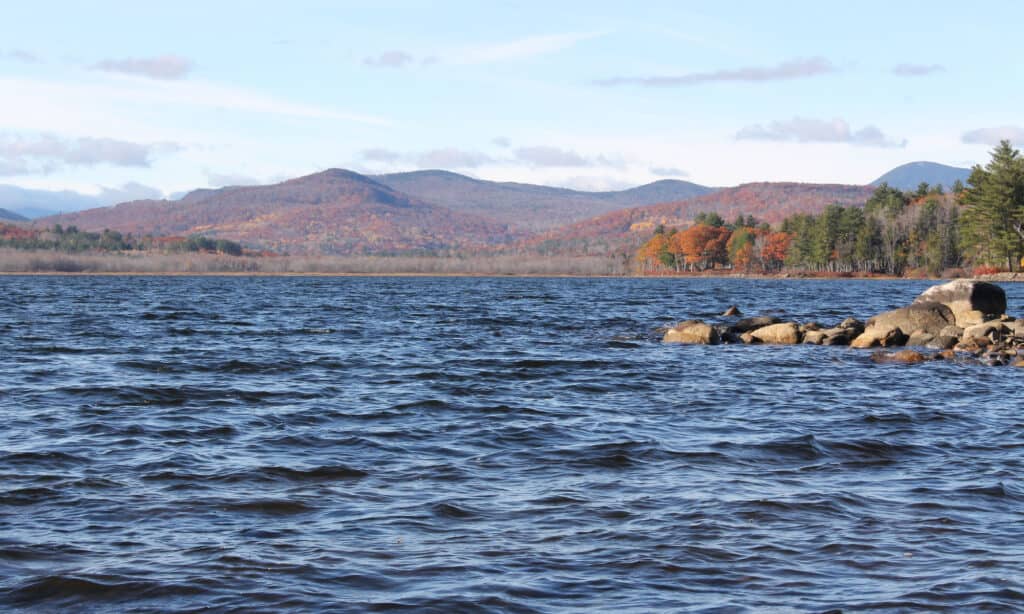
Located in central Kansas, Wilson Lake is famous for its striped bass and walleye fishing.
©Madelyn Hart/Shutterstock.com
Wilson Lake is in central Kansas. The area has the Wilson State Park, Minooka Park Recreation Area, and Lucas Park Recreation Area along its borders. The lake has a wide assortment of animals living along its borders and in the water. A few of the snakes that you can run into in this area include the plains garter snake, bull snakes, and common watersnakes. The area is known for having many snake species in the area, but not many venomous snake sightings.
1. Milford Lake
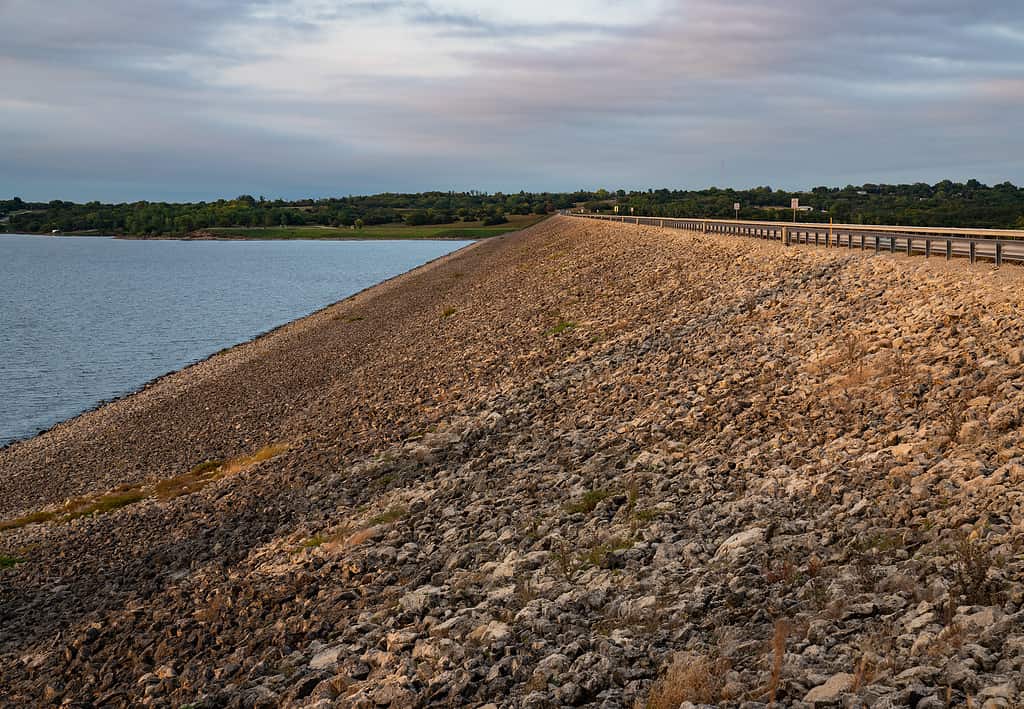
The Milford Dam created Milford Lake on the Republican River in Kansas.
©Tony Webster from Minneapolis, Minnesota, United States / CC BY 2.0., via Wikimedia Commons – Original / License
Milford Lake is tied for the deepest lake in Kansas, and it’s also one of the most snake-infested lakes in Kansas as well. The lake is located in the northeastern part of the state, about 10 miles west of Manhattan and Tuttle Creek Lake. Some of the snakes that visitors may see in this area are the western rat snake, common watersnake, common garter snake, timber rattlesnake, eastern copperhead, and eastern hognose snake. Copperheads and timber rattlesnakes are dangerous, and it’s important to watch for each of them.
People can encounter a wide variety of snakes in Kansas. While most of them are non-venomous, some of them are venomous and live near the water. Practice good snake safety by giving these creatures a wide berth and never backing them into a corner.
The vast majority of snakes would rather flee from a person than bite them. It is important to realize that snakes can swim, and they can also bite while swimming. Never harass a snake that is swimming in these lakes, especially if it is a venomous species. Anyone bitten by a venomous snake species must seek immediate medical attention to have the best chance of surviving with as few complications as possible.
Summary of the Most Snake-Infested Lakes in Kansas
| Rank | Lake | Snakes |
|---|---|---|
| 5 | Fall River Lake | Copperhead, common watersnake, and western milk snakes. |
| 4 | Cheney Lake | Copperheads, common watersnakes, gopher snakes. |
| 3 | Tuttle Creek Lake | Copperheads, diamondback watersnakes, plain-bellied watersnake. |
| 2 | Wilson Lake | Plains garters snake, bull snake, common watersnake. |
| 1 | Milford Lake | Timber rattlesnake, copperhead, common garter snake, common watersnake. |
Thank you for reading! Have some feedback for us? Contact the AZ Animals editorial team.

